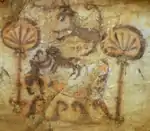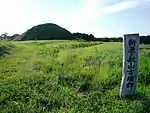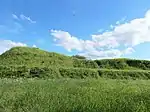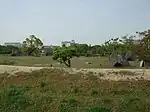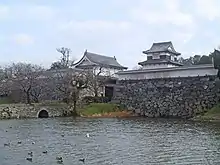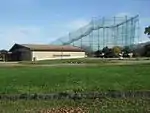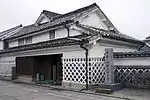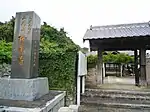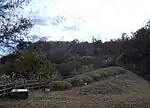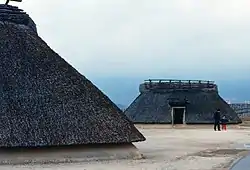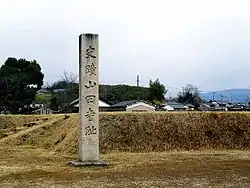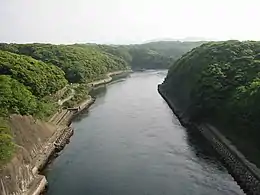This list is of the Historic Sites of Japan located within the Prefecture of Fukuoka.[1]
National Historic Sites
As of 1 December 2020, ninety-seven Sites have been designated as being of national significance (including five *Special Historic Sites); Kii Castle spans the prefectural borders with Saga and the Mitsui Miike Coal Mine Sites those with Kumamoto.[2][3]
Prefectural Historic Sites
As of 1 May 2020, eighty Sites have been designated as being of prefectural importance.[20]
Municipal Historic Sites
As of 1 May 2020, a further two hundred and nineteen Sites have been designated as being of municipal importance.[23]
See also
Wikimedia Commons has media related to National historic sites in Fukuoka prefecture.
Wikimedia Commons has media related to Prefectural Historic Sites in Fukuoka Prefecture.
References
- ↑ "Cultural Properties for Future Generations". Agency for Cultural Affairs. Retrieved 3 January 2021.
- ↑ 史跡名勝天然記念物 [Number of Monuments of Japan by Prefecture] (in Japanese). Agency for Cultural Affairs. 1 December 2020. Retrieved 3 January 2021.
- ↑ "Database of National Cultural Properties: 史跡名勝天然記念物 (史跡, 特別史跡 福岡県 2県以上)" (in Japanese). Agency for Cultural Affairs. Retrieved 3 January 2021.
- ↑ 王塚古墳 [Ōzuka Kofun] (in Japanese). Kyushu National Museum. Archived from the original on 4 March 2016. Retrieved 7 December 2013.
- ↑ 国指定特別史跡 基肄城跡 [Kii Castle] (in Japanese). Chikushino City. Retrieved 8 July 2013.
- ↑ 基肄城 [Kii Castle] (in Japanese). Kiyama Town. Archived from the original on 16 October 2013. Retrieved 8 July 2013.
- ↑ Aston, W.G (1972) [1896]. Nihongi: Chronicles of Japan from the Earliest Times to A.D. 697. Vol. 2. Tuttle. pp. 283f. ISBN 0-8048-0984-4.
- ↑ 浦山古墳 [Urayama Kofun] (in Japanese). Kyushu National Museum. Archived from the original on 5 March 2016. Retrieved 4 December 2013.
- ↑ 下馬場古墳 [Shimobaba Kofun] (in Japanese). Kyushu National Museum. Archived from the original on 4 December 2013. Retrieved 7 December 2013.
- ↑ 五郎山古墳 [Gorōyama Kofun] (in Japanese). Kyushu National Museum. Archived from the original on 4 March 2016. Retrieved 7 December 2013.
- ↑ 桜京古墳 [Sakurakyō Kofun] (in Japanese). Kyushu National Museum. Archived from the original on 4 March 2016. Retrieved 7 December 2013.
- 1 2 "Okinoshima Island and Related Sites in Munakata Region". UNESCO. Retrieved 7 December 2013.
- 1 2 "Okinoshima Island and Related Sites in Munakata Region" (PDF). World Heritage Promotion Committee of "Okinoshima Island and Related Sites in Munakata Region". pp. 6f. Archived from the original (PDF) on 12 December 2013. Retrieved 7 December 2013.
- ↑ 竹原古墳 [Takehara Kofun] (in Japanese). Kyushu National Museum. Archived from the original on 4 March 2016. Retrieved 9 December 2013.
- ↑ 塚花塚古墳 [Tsukahanazuka Kofun] (in Japanese). Kyushu National Museum. Retrieved 9 December 2013.
- ↑ 日岡古墳 [Hinooka Kofun] (in Japanese). Kyushu National Museum. Retrieved 9 December 2013.
- ↑ 日輪寺古墳 [Nichirinji Kofun] (in Japanese). Kyushu National Museum. Archived from the original on 4 March 2016. Retrieved 9 December 2013.
- ↑ 萩ノ尾古墳 [Haginoo Kofun] (in Japanese). Kyushu National Museum. Retrieved 9 December 2013.
- ↑ "Sites of Japan's Meiji Industrial Revolution: Iron and Steel, Shipbuilding and Coal Mining". UNESCO. Retrieved 6 August 2019.
- ↑ 都道府県別指定等文化財件数(都道府県分) [Number of Prefectural Cultural Properties by Prefecture] (in Japanese). Agency for Cultural Affairs. 1 May 2020. Retrieved 3 January 2021.
- ↑ 狐塚古墳 [Kitsunezuka Kofun] (in Japanese). Kyushu National Museum. Archived from the original on 4 March 2016. Retrieved 7 December 2013.
- ↑ "新開村旧てい記碑 Shinkai-mura Old Stele" (in Japanese). Miyama City. Retrieved 7 December 2013.
- ↑ "都道府県別指定等文化財件数(市町村分)" [Number of Municipal Cultural Properties by Prefecture] (in Japanese). Agency for Cultural Affairs. 1 May 2020. Retrieved 3 January 2021.
External links
- Cultural Properties of Fukuoka Prefecture (in Japanese)
This article is issued from Wikipedia. The text is licensed under Creative Commons - Attribution - Sharealike. Additional terms may apply for the media files.



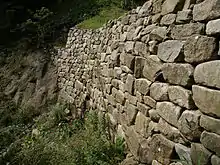

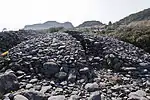

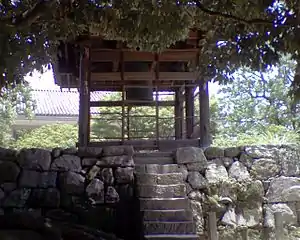



.jpg.webp)





.JPG.webp)







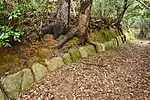


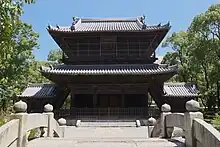

_gakko-in.JPG.webp)
